FILM MUSIC RECORDINGS REVIEWS |
|
|
FILM MUSIC RECORDINGS REVIEWS |
|
|
March 1999
© Film Music on the Web 1999. All rights retained. Reviewers retain copyright on their reviews. Disclaimer
![]() COMPETITION WIN
a CD of your Choice from Crotchet
COMPETITION WIN
a CD of your Choice from Crotchet
![]()
************************************************************** Editor's Choice - CD of the Month - March 1999
**************************************************************
Dmitri SHOSTAKOVICH The Film Album Riccardo Chailly conducts the Royal Concertgebouw Orchestra
DECCA 460 792-2 [78:02]
The Counterplan; Alone; The Tale of the Silly little Mouse; Hamlet; Sofia Perovskaya; Pirogov; and The Gadfly.
************************************************************** EDITOR'S RECOMMENDATION March 1999
**************************************************************
Franz WAXMAN (1906-1967) The Song of Terezín Eric ZEISL (1905-1959) Requiem Ebraico Deborah Riedel (soprano); Della Jones (mezzo-soprano); Michael Kraus (bass-baritone) Rundfunk-Kinderchor Berlin; Rundfunkchor Berlin; Rundfunk-Sinfonieorchester Berlin conducted by Lawrence Foster
DECCA 460 211-2
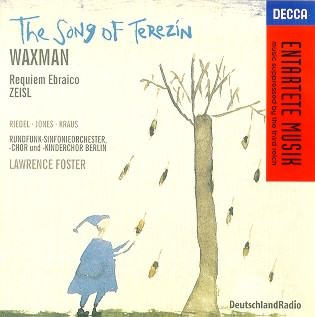
To quote Michael Haas, the executive producer of this album, "These works are the reactions of two European-born Hollywood composers to the Nazi show camp of Terezín. Waxman's work is a powerful song cycle using the words of the children of the camp, while Zeisl's Requiem in memory of his murdered father is an emotional and moving liturgical work.
Franz Waxman, of course, enjoyed considerable success as a composer of music other than for the screen and it must be remembered that he, himself, had experienced Nazi brutality in 1934 and had fled Germany after he had been beaten up on the streets of Berlin. The Song of Terezín was composed between November 1964 and February 1965; it is therefore a late work. Its overall mood is of tragic melancholy; only in a few places does the music become somewhat light-hearted as in the song of "The little mouse" but even here there is a sense of heavy irony and there is a steely edge to the music. The opening movement, with its jack-boot like figures, represents the barbarity and cruelty of the concentration camp but elsewhere in these songs there is also defiance and a hope for better things as well as a sense of cold remoteness and despair. Waxman's command of dramatic tension and colourful orchestral writing is always evident and his music reflects the influence of Schoenberg, Richard Strauss, Zemlinsky and Berg. The final movement, "Fear", is a poignant and chilling indictment of the Holocaust: O God! Do not forsake us in our pain - Death is coming...Do not forget us..."
Eric Zeisl, after escaping the Nazi regime in Austria, escaped via Paris and New York to Los Angeles where he collaborated on more than 20 films before concentrating on compositions outside the film world. His Requiem Ebraico enjoyed considerable success. It is a much warmer work than the Waxman. Composed in one continuous movement, it alternates choral, solo and duet passages. To quote from Manuela Schwartz's notes, "...the expressive Romantic school of Mahler or Bartok and French models like Fauré, combine with oriental traits to form an impressive musical whole." The music is often very beautiful and, although the baritone solo "Oh how great are thy works.." introduces darker figures to cover the struggle between good and evil, the work ends in a glorious life-affirming fugal chorus culminating in a glorious major chord.
The Berlin choirs, soloists and choirs under Lawrence Foster, who, incidentally is pictured with Franz Waxman in the booklet, give excellent committed performances. A sometimes harrowing but a deeply moving musical experience that every serious student of the Golden Age of film music ought to have in their collection.
Reviewer
Ian Lace

************************************************************** EDITOR'S RECOMMENDATION March 1999
**************************************************************
Jerry GOLDSMITH Star Trek: The Motion Picture (20th Anniversary Collectors' Edition) Music conducted by the composer
COLUMBIA/LEGACY C2K-66134 2CDs [65:06/64:29]
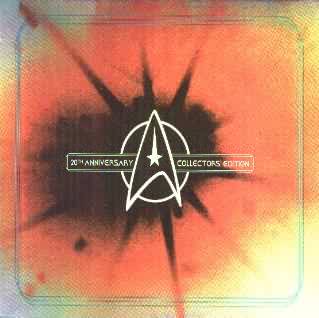
Here at last, this glorious end result has probably had the most drawn out release history of any soundtrack. Depending on your completist level, this should hopefully satisfy most.. There are just a few cues still missing, but it’s as close as Goldsmith actually wants you to get.
So live with it !
The first sign that we are being looked after is the considerate placing of "Ilia’s Theme" at the start of the disc. This was the now defunct idea of an Overture to the presentation of a film, and so is much better off preceding the score than slowing the pace half way through as it did in the earlier releases.
It is naturally the previously unreleased cues that are the kindest gift to the listener however. The material for Spock is ("Total Logic" and "Spock’s Arrival") are wonderful to have since they demonstrate just how diverse the score always was. We’ve become so familiar with the brassy fanfare, Klingon percussion, and digital cloud effects. The fact that at least one alien culture was represented musically got lost behind that.
A couple more new cues allow for the appreciation of the Blaster Beam in all its glory for the mysterious cloud. A great example is "Inner Workings", which seems to want to deify the machine they discover with a religious fervour to the music. In "Vejur Speaks" we get the impression that when Decker tells us V’ger (correct spelling) wants to "touch God", Goldsmith took this as a cue to imbue the pre-Borg conscious machine with a truly Godly aura.
There are so many blindingly bright points to the score really. I have personally always considered it to be one of the greatest scores ever written, and that it should have won from its Oscar nomination. Technically everything was against the composer - timing especially. Yet it still stands as one of the most sought after soundtracks some 20 years on.
The other talking point about the release is the 2nd disc featuring interviews with cast
members. It should be noted that this relates to the series. Makes for a fun listen nonetheless.
Reviewer
Paul Tonks
(& beyond !)
After years of lies, deceit, treachery, broken promises, and sad excuses, there is finally proof that the "Star Trek: The Motion Picture" expanded CD does exist! Hooray!
While an overrated score in some respects ("Star Trek: TMP" is not better than Goldsmith's collaborations with director Franklin Schaffner), it deserves the vast majority of its mountainous praises. The use of 'blaster beams,' 'glass rub rods,' electric guitars, synthesizers, and water-submerged bells in a predominately orchestral score give a brightly original soundscape not incomparable to the work of Igor Stravinsky. Full of innovation and high inspiration, this symbolized film music on the edge of a new cinematic and dramatic frontier. For example, less than a year after the original soundtrack's release composer James Horner utilized large portions of Goldsmith's score in "Battle Beyond the Stars," arguably more closely than the law should concede.
This recording presents the music in film chronological order and as complete as the composer would allow. Every single one of the old favorites returns alongside newly released tracks such as the excellent (logically so) 'Total Logic,' the surprise of 'Spock's Arrival,' the questing 'Games,' the eerie 'Inner Workings' of Vejur, and a good 'A Good Start.' The assortment of ideas is altogether astonishing.
The 'bonus' "Inside Star Trek" CD warrants a one-time listen. Limited educational value and excessive corniness keep it from being more worthwhile. However, there are a few things that shine, particularly Gene Roddenberry's lecture. Much of the disc is unquestionably archaic, but if approached as a time capsule there is the potential for some fascinating discoveries.
The packaging is a combination of the original soundtrack design by Bob Peak, as well as the ship schematics look of the "Inside Star Trek" record, inside a handsome lasered slipcover (anyone attracted to shiny objects should get some fun out of the construction). The sound for the OST is superexcellent. The sleeve notes by David Hirsch and Ford A. Thaxton are concise yet informative.
The Enterprise theme, Ilia's theme, the space station music, the Vejur music, the deep motives for Spock, the aggressive Klingon motif, the emotional charge of the orchestrations: This is classic filmusic and should not be missed by anyone, anywhere, for any reason.
Besides, this is an item where computer dweebs, sci-fi geeks, and soundtrack nerds can happily converge...
Reviewer
Jeffrey Wheeler

************************************************************** EDITOR'S RECOMMENDATION March 1999
**************************************************************
Collection: WATCH THE SKIES Various artists
SONIC IMAGES SID-8901 [73:31]
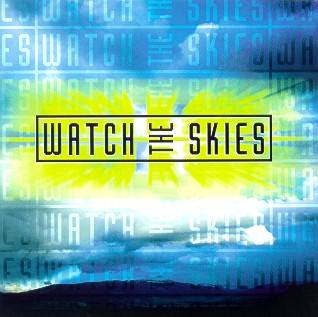
Collection features music from: The Day the Earth Stood Still; Mars Attacks; Species; E.T.; Contact; They Live; Men in Black; Predator; Aliens - The Ride; Alien; Invasion of the Body Snatchers; Roswell; The Tommyknockers; Dark Skies; The X-Files; Independence Day
This a cracking collection intelligently compiled and generous in its almost 74 minute length. The sound is absolutely stunning. The album contains material from the Telarc and Silva Screen libraries plus some material that has never been released before
The compilation kicks off with Bernard Herrmann's ground-breaking music, for The Day the Earth Stood Still using, so very imaginatively the theremin, electronic violin, electronic bass and electric guitar. Immediately afterwards we get Danny Elfman's cheeky send up of the 1950s sci-fi music in his score for Mars Attacks and, later, his wild and whacky Men in Black music given some extra magic by John Beal. Christopher Young's marvellous and mesmerising score for Species proves that you can be quietly malevolent. John Williams is represented by his E.T. music in a nice relaxing piano solo medley played by Michael Chertock.
Alan Silvestri's lovely music for Contact was one of my favourite scores of 1997- beautifully serene and compassionate in stark contrast to the other Silvestri score here, the harsh and relentlessly driving rhythms of Predator, this performance produced and performed by John Beal. They Live has a sleazy, slinky theme from John Carpenter and Alan Howarth while Richard Band's creepily exciting music, based on James Horner's Aliens theme, designed to heighten the thrills of a popular Aliens amusement park ride. Jerry Goldsmith's End Title from Alien is broods upon the vastness of space, the music growing almost Vaughan Williams mystical.
Three or four tracks are devoted to electronic led scores: Denny Zeitlin's quirky and increasingly eerie music for Invasion of the Body Snatchers; Elliott Goldenthal's spooky synthesizer score for the cable-TV movie, Roswell; Christopher Franke's equally eerie electronic score for the Stephen King shocker, The Tommyknockers; and Michael Hoenig's more introspective electronic/acoustic Epilogue music for the TV series, Dark Skies.
One of the most interesting tracks is Donald Fraser's arrangement of Mark Snow's theme from the X-Files - arranged, very cleverly, in the style of Alan Hovhaness.
The programme ends in great style with David Arnold's End Credits from his Independence Day score given an absolutely cracking performance by the City of Prague Philharmonic Orchestra and Crouch End
Reviewer
Ian Lace
tar.gif)
************************************************************** EDITOR'S RECOMMENDATION March 1999
**************************************************************
Bernard HERRMANN - Citizen Kane - The Essential Collection City of Prague Philharmonic conducted by Paul Bateman and Nic Raine
SILVA SCREEN 2CDs FILMXCD 308 [110:44]

Selections from: The Man Who Knew Too Much; Citizen Kane; On Dangerous Ground; North by Northwest; The Seventh Voyage of Sinbad; The Ghost and Mrs Muir; Torn Curtain; The Twilight Zone; Marnie; The Snows of Kilimanjaro; Cape Fear; Jason and the Argonauts; The Naked and the Dead; The Day the Earth Stood Still; The Three Worlds of Gulliver; Obsession; Psycho; Mysterious Island; The Trouble with Harry; Vertigo; Taxi Driver.
The obvious question that occurred to this reviewer was - with so many outstanding recordings of Bernard Herrmann's film music, made by so many first class orchestras, under conductors of the calibre of Charles Gerhardt, Elmer Bernstein, Esa-Pekka Salonen, Joel McNeely etc, not to mention Bernard Herrmann himself, is there room for yet another anthology - and, if so, what extra merit does this new album have?
The answer is threefold. First of all the sound is stunning - well up to Silva Screen's very best allowing full textural clarity of these generally splendid performances set in a full and wide perspective. Secondly the majority of the performances of the better known works equal if not surpass any performance already available: the much recorded Psycho suite has some interesting rubato that I think Bernie would have approved of; and the equally oft-recorded Vertigo sounds superb, so too does the Marnie Prelude; and A Portrait of Hitch (The Trouble with Harry) can stand beside Herrmann's own Decca recording but with the added advantage of superior modern sound; and, for me, the Christopher Palmer's suite Night Piece for Saxophone and Orchestra assembled from Taxi Driver has never sounded better. Thirdly there is the adventurous choice of material with some selections rarely committed to disc.
The programme's opens with the thrilling, rarely recorded Prelude from The Man Who Knew Too Much - a menacing, sinister piece with a hint of its earlier Northern African setting. A very cheeky, perky, characterful rendition of the Citizen Kane follows - a brilliant performance this one! On Dangerous Ground is represented by a five-movement suite so that we have the chance to evaluate more of the music than was on the Charles Gerhardt/ RCA anthology. Here we have the exciting horn chase music shared between the "Prelude" and "The Hunt" cues in between we have some of Herrmann's warmest and sympathetic writing, for the loving and caring character of the blind Mary, that anticipates his Vertigo and Marnie music. On balance though, I prefer the sheer excitement generated by Gerhardt.
It is good to have the romantic interlude, "Conversation Piece" between Cary Grant and Eve Marie Saint, set aboard a train in North by Northwest (as well as the urgent, colourful "Prelude"). "Conversation Piece" is another rarely recorded item. The music is full of sexual tension and the motion of the train is subtly apparent too. Herrmann's lovely impressionistic seascape and romantic music for The Ghost and Mrs Muir is beautifully played - so too is the Memory Waltz from The Snows of Kilimanjaro - in fact I think this is the most persuasive performance of this piece that I have heard. The lovely waltz from Obsession is also persuasive but I do wish room could have been made for the compelling and chilling music that Herrmann created for the scenes in which Cliff Robertson delivers the ransome money.
Another welcome addition is the score that never was - the Hitchcock- rejected music from Torn Curtain - represented here by a powerful three movement suite cold, sinister and ferocious. The music for the famous scene where Gromek is killed at the farmhouse is particularly chilling and this performance is every bit as compelling as the recent more complete Varèse Sarabande recording. Cape Fear was another dread, claustrophobic, atmospheric, Herrmann score and is represented here by a three movement suite - another welcome rarity.
Entirely new to me was the music for The Naked and the Dead about incidents in the Pacific theatre of operations in World War II - full of military swagger, with much brass an drums but ultimately cold and cruel.
Hermann's more exotic scores are represented by rousing and colourful readings of The Seventh Voyage of Sinbad Main Title; and the Prelude to Jason and the Argonauts, the latter's heroic splendour and assertive confidence is powerfully conveyed. Five cues of music represent the Mysterious Island score with the opening cue memorable for its huge stereophonically placed cymbal clashes. The music representing the horrific giant monsters is typically Herrmann-graphic.
Another interesting rarity is the Overture to The Three Worlds of Gulliver mixing typical British pride and splendour with dainty figures for the diminutive Lilliputians and ponderous heavy ones for the giants of Brobdingnag. Sci-fi is represented by a compelling performance of the music from The Day the Earth Stood Still with its advanced (for its day) electronic instrumentation, counterbalanced by a brilliant evocation of "Radar" using just piano. A clutch of quirky, grotesque but always intriguing figures makes up the cue "Themes" from The Twilight Zone - how many of today's sci-fi and fantasy scores have been influenced by them I wonder?
Heartily recommended.
Reviewer
Ian Lace
tar.gif)
And a view from Rob Barnett
It was only a matter of time before Silva Screen got round to Herrmann. The strange thing is that it took so long. This is an ambitious and far from cliché-ed collection and the result is creditable and attractive. It is not especially generous in timing, at least not against the standards Silva have set for themselves. Their collections series (two for the price of one) usually manage more than an hour; often as much as 70 minutes, per disc. This offers less than an hour each disc.
Lacking also are any stills from the films nor any photo of Herrmann not that either of these is any real hardship! The cover illustration gives a more than passable impression of Xanadu's mysterious opulence. David Wishart's intelligent and informatively readable English-only notes (12pp) compactly profile the essentials of each film, placing it in time and with methodical references to plot and leading actors. All recording details are well given though it is a pity that it is not easier than it is to find out which tracks are conducted by Bateman and which by Raine.
CD1 begins confidently with the splendidly crashing prelude from The Man Who Knew Too Much. The Kane Overture is brightness, nimble jollity and innocence but gradually passing through boozy Prokofiev and Shostakovich like moments into a grandly Hispanic bombastic march compleet with a sly reference to The Conquering Hero. There seemed to be a lack of crispness in the performance but there is no lack of gusto.
I have no doubt been spoilt by the Gerhardt recording of the Prelude On Dangerous Ground. The Praguers are no match though enjoyable in their own right. This collection offers five movements from the film. Blindness is a viola serenade of inward tenderness exploring Herrmann's slightly cool emotional 'no man's land'. The silence is conjured through Sibelian rustling and high pitched strings. The hunt has those galloping French horns conveying pounding chaotic energy like the Four Horsemen of the Apocalypse. The finale opens in an Iberian spectral beauty. There is a glorious harp 'melt' à la Marnie and the track ends in cinematic grandeur.
The thudding drums of North by North West do not have the snap and definition of Laurie Johnson's rushed performance. Many of the contours have been chamfered and I missed that roughness and violence. The recording is excellent though and for first time I was struck by the downward swooping glissando towards the end of the movement clearly recalling Elgar Symphony No. 2 a work which Herrmann no doubt conducted with the CBS in the 1930s or at the very least knew from scores he imported into the US. Then comes the sensuous Conversation Piece with its soft beating heart and tastefully swooning strings. This is exceptionally well done and is one of the stand-out tracks in the collection.
This contrasts with fine sparkle of the slightly breathless Seventh Voyage of Sinbad main title. No lassitude here at all!
The Ghost and Mrs Muir's prelude is a great surging uprising projected through the strings. This sense of marine and emotional 'welling up' is brilliantly conjured. Very fine. Then comes the proto-Mahlerian Adagietto which is very English, brittle in the winter sunshine. The bells at 2:20 might almost be Housman's 'Noisy Bells'.
Herrmann joyed in hunt motifs. Here is another one (though rather lethargic) decking out Torn Curtain or it would have but for Hitchcock's rejection of the slate-grey score. The Gromek cue has a floating menace while The Killing is notable for its understatement and little whip-like figures.
As a break from film The Twilight Zone takes us into TV. The twitteringly intense theme has found its way into popular culture. People know it without knowing who earth Bernard Herrmann was. High tribute. This version emphasises the guitar part. The textures are interesting and splendidly menacing. It is slightly like Holst's Neptune and of course Herrmann knew Holst's Planets and conducted it in a reputedly rather elephantine recording for Decca Phase Four.
The Marnie prelude instantly sweeps us into the irresistibly chilly romance with a string theme that at least once reminds us of Tchaikovsky's Pathéthique Symphony. The performance and recording catch a lump in the throat and a shiver down the spine. This is a Classic Herrmann creation and is totally cherishable. This is another track for sampling. The Snows Of Kilimanjaro's Memory Waltz is a music box type dance of the type we know from The Magnificent Ambersons. It is given excellent pacing and swing with twists and turns which occasionally look in a slightly self-satisfied way towards Korngold.
Cape Fear pitches in with another death hunt with barking patterned horns and shuddering strings. The other tracks are haunted (The School and Panic) and the final track of the three is all decay and crestfallen horns: lichen trailing off castle walls. It concludes with the brass (sounding like escapees from the more Sibelian moments in Bax's Fifth Symphony) on a very good day whooping triumphantly. The disc closes with the bombastic stalking march-prelude from Jason and the Argonauts. This is all a bit empty. Herrmann on cruise control.
The second disc opens with the rare Prelude from The Naked And The Dead. This is predictable stuff and gets up where the Jason prelude sat down. Militaristic hammering and clamant brass, calls to battle and slippery vainglory with a momentary recollection of Bliss's march from Things to Come.
The following three tracks are of music from The Day The Earth Stood Still. This is all quite nicely done though the theremin could have had more presence. Radar has a feverish edgy urgency. Just right. In fact this is probably the best recording available. The Finale and Farewell is sanely paced.
In utter contrast comes the 'big beef' pastiche Handelian teutonic march of the overture to The Three Worlds Of Gulliver. It is all glitter and the bombast offset by miniature harp concerto references. Elgar orchestrated Handel and Herrmann seems to be at ease in similar territory though he did not return there.
Back again to the world of Marnie, Ghost and Conversation Piece for the valse lente from Obsession - a 'heart's partner' to these pieces of elusive and tremulous romance. The music conveys a mood completely at odds with Psycho (five tracks) which in this performance struck me as rather slack. There is little urgency in the prelude and rainstorm music though Murder is well conveyed. It is uncompetitive with Herrmann's own performance and the recentish complete Varèse-Sarabande CD. Turning now to Mysterious Island there are five cues all well done but these mechanistic illustrations, well done though they are, impress only as clever sound pictures rather than as music. There seems to be little emotional content.
A Portrait of Hitch is an 8 minute tone poem using the music from The Trouble With Harry. This is quirky and jerky like a brutally playful Shostakovich theme. The playground song is well put across. How touchingly the players articulate the lovely innocent song at 2:12. At 3:10 Herrmann again pulls another incredible tune out of the hat. It must have been an Astrakhan hat given the distinctly Russian caste of the melody - unmissable. Much of the piece is Russian in feel with Prokofiev's Peter and the Wolf not far away.
Vertigo is a very well known film and the music is represented through three tracks. The first mixes characteristic high notes with music box miniatures (prelude). Castanets are a strange but effective presence is the essentially very disturbing Nightmare. Finally The Scene D'amour is ghost-like and so cold rather like the doomed garden spirits at the end of James Elroy Flecker's Hassan blowing away into utter negation. The head pounding Tchaikovskian climax is powerfully conveyed with an especial debt to the strings welling up in spectral passion. This is very well done.
Finally we get the 8 minute long Night Piece carved from the music for his last film Taxi Driver - another irresistible score. Wonderful film music. I am so glad that it is here and lovingly 'rolled' by the reedy saxophone. The performance wants a sinister cutting edge which the legato swoopy smoothness of this account denies. Still - a nice alternative view.
In summary: this set is as good an introductory two disc anthology to Herrmann as you will find. Snap it up. If there are some miscalculations they are minor. For the rest you will be lead on to discover a much fuller legacy than better individual single CD collections (Salonen) can offer. As a two disc anthology it does not really compete with anything else on the market.
Recommended.
Reviewer
Rob Barnett

Thomas NEWMAN Meet Joe Black OST
UNIVERSAL UND 53229 [52:02]
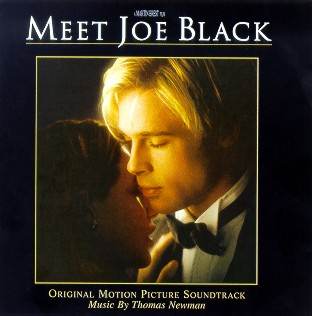
Meet Joe Black received mixed reviews. Could one really imagine heart-throb Brad Pitt as the Grim Reaper? Credulity is strained still further when he falls for Claire Forlani daughter of mogul Anthony Hopkins whom he, Death/Joe Black, has come to claim but allows a stay of execution provided Hopkins gives him a guide to human life.
Thomas Newman delivers a thoughtful, understated score of mainly slow, quiet, strings-dominated music for this essentially romantic drama. The opening cue "Yes" is mysterious and timeless. This sense of timelessness and time moving forward is nicely captured in the second cue "Everywhere Freesia", which invokes classical, neo-classical, impressionistic and romantic styles as though suggesting that Death like taxes is always with us.
The string-led melody for "Walkaway" has a haunting and limpid beauty. "Meet Joe Black" mixes string shudders (a nice little touch) with warmer material but the overall mood which Newman cleverly creates is one of daunting mystery but at the same time the music is also curiously inviting and sensuous - an example of how adept Newman is at creating a mix of emotions and moods.
"The Peanut Butter Man" another mysterioso cue that mixes hesitant pizicatti walking figures with quietly grotesque woodwind and percussion and piano figures; a remarkably imaginative cue. Another interestingly scored cue is "Fifth Avenue" deep bass drum beats and cross-rhythmed strings with softly brushed cymbals and clarinet make this a very colourful walk.
Many of the cues such as "Whisper of a Thrill" are hushed romantic experiences until later in the cues "Served its Purpose", "Sorry for Nothing", "Mr Bad News", the orchestration broadens, the tempos quicken or the music darkens for the dramatic crisis. Again Newman superbly, elegantly creates just the right atmosphere and avoids the usual clichés. The most stark cue is "The Question" sounding bleakly remote and hollow. "Someone else" which follows is another lovely cue poignant and slightly reminiscent of Vaughan Williams.
In the considerable 10 minute cue "That Next Place" we have music that rises to forte as it sings gloriously of hope and affirmation as well as recapitulating the earlier lovely romantic material.
The album also contains music from, presumably, the ballroom sequence - i.e. very attractive renderings of Irving Berlin's "Cheek to Cheek" and "Let's Face the Music and Dance", and George Weiss's and Bob Thiele's "What a Wonderful World."
A nice album to consider as relaxing late night listening. Another feather in Thomas Newman's cap.
Reviewer
Ian Lace

1999 Academy Award Nominated Score -
Randy NEWMAN A Bug's Life OST
EDEL 0106342DNY [47:43]
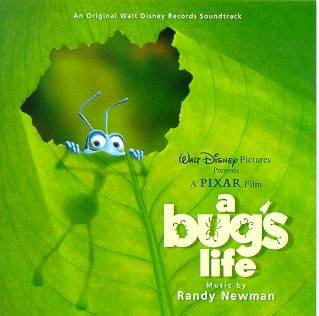
This is a lively, vibrant score full of colour and good humour. As in Pleasantville Randy Edelman creates a warm score full of irony, rich characterisation and parody. There is enough variety too to keep the ear entertained through its 47 minutes duration except for, perhaps, a little repetition of material in the later tracks.
We hear Randy himself singing in the song, "The Time of Your Life" which is the first track but I guess we'll gloss over that one quickly and proceed to the score proper. "The Flick Machine" takes us back to the up-beat big band jazz/swing sounds of the 1940s and '50s - a sort of hangover from Pleasantville. "Seed to Tree" reminds us of the traditional Walt Disney twee and tripsy-whipsy music we all associate with very young animal cartoon-characters but with some added Newman spicy spin. "Red Alert" is cartoon capers chase music again with some nicely observed Newman nuances. "Hopper and his gang", the film's cricket heavies (in shape and character) get the heavy treatment with music suggesting their lumbering gait and grousy, overbearing manner. In such tracks as "Flick leaves" and "Robin Hood" we hear clever parodies of bold and brassy western themes and the heroic music of Korngold all overlaid with material still reminding us that these are bugs. "Circus Bugs" goes back to the exotic music of the 1920s with exotic Arabian jazz sounds - a sort of Ketelbey pastiche. The final "A Bug's Life Suite" includes homely, Americana music and material that one associates with the old silent cinema banana peel slapstick combined with sentimentality. We even get a quote from Psycho in the "Victory" cue when we hear those screeching shower murder chords to denote, I assume, the come-upance of Hopper.
I will admit to having got a lot of childish pleasure from this CD
Reviewer
Ian Lace

1999 Academy Award Nominated Score -
Marc SHAIMAN Patch Adams OST
UNIVERSAL UND 53245
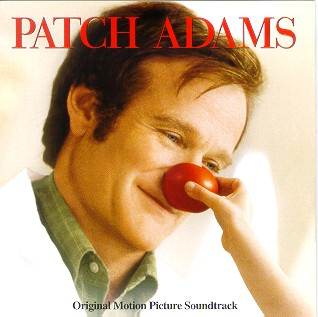
Nominated in the Original Musical or Comedy Score category, Patch Adams music is a mix of source material, from such artists as Rod Stewart, Eric Clapton and The Rascals, and an original score by Shaiman. For this romantic comedy with Robin Williams clowning in a children's ward, Shaiman creates a surgingly romantic score with all guns blazing - the snag is that the main theme is not strong enough to linger in the memory. Nevertheless, listening to it, and imagining it in combination with the on-screen images, I doubt if there will be a dry eye in the house.
This score is very pleasant and heart-warming but it says little new, beyond offering one or two interesting harmonic twists - it treads a well worn path. Its the sort of music one associated with the 1940s women's tear-jerkers - in fact there are one or two tell-tale Max Steiner nuances. The music is often poignant and its child-like innocence clearly echoes the screenplay. I would mention just a few of the tracks: "Ranch Reveal" adds some country-style seasonings; "Hello" is a much more interesting, livelier cue - it begins rather like a syncopated minuet and it contains some arresting rhythmic patterns and quirks. "Speech" seems to be all about anticipation but here Shaiman treads perilously along a fine line and almost trips over into the cloying. "Front Porch" is quietly introspective and romantic. "Butterfly/Noodle Pool" offers nicely evocative impressionistic portraits of the emerging glory and beauty of the butterfly tinged with a little sadness for, one imagines, its short life; and childish high-spirited play is captured in the Noodle Pool segment. "The Ruling/Graduation" is a heroic triumphant statement of the main theme. Very pleasant and very safe - an ideal for the Academy judges.
Reviewer
Ian Lace
tar.gif)
This month we have three scores from Danny Elfman: two new ones and a classic:
Danny ELFMAN A Simple Plan OST
GOLD CIRCLE /COMPASS RECORDS COM 0105 [43:53]
Please note that titles on COMPASS III are available WORLDWIDE ex North America, on SILVA SCREEN RECORDS.
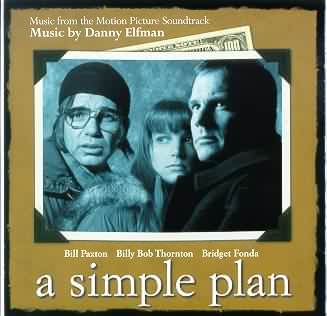
Although A Simple Plan has gathered Oscar nominations for Billy Bob Thornton in the Supporting Actor category and for Screenplay-Adaption, it is hardly surprising that the conservative Academy would risk a nomination for such a daring score as the one Danny Elfman has created for this film.
In an interview, Elfman has agreed that it is a subtle rather than a bombastic action/thriller score. Talking about its unusual orchestration, he commented, "Very often in a movie I design the score around a sound or sounds that I think will be unique to that picture. Certainly in a movie like A Simple Plan it needed some special or unique tones, the tone of the movie was very tricky. So there are two thematic areas, one of them was a flute ensemble. It was a fun orchestra for me to work with because there was really no brass, no percussion. It was just flutes, lots of flutes, nine of them mostly alto and bass. That was kind of a fun thing, very, very simple, sparse ensemble led by alto and bass flutes. The other part of it was these specially tuned pianos that I prepared before I started and specially tuned banjos... Starting with these two odd tonal groups, I began composing the score..."
So does it work? Well, yes it does. Elfman uncannily catches the intense chill of a wooded landscape in the iron grip of winter, and the human emotions and drama proceeding against this backdrop. The Main Title is icy and crystalline, the music, using the effects that Danny describes above, glissandos between tonality and dissonance giving a remote feeling and also a sense of intense cold before the entry of the piano ushers in warmer, more humane music. "The Moon" is a hoary-frosty, impressionistic picture using vibrating- reed woodwinds very creatively, together with those little fairy bells. For "The Farm" Elfman uses harp and strings to depict its isolation amongst the icicles (you can hear them tinkle) with snatches of dissonance at odds with warmer music portraying the warmth inside the farmhouse. "Betrayal" is a crescendo in menace with odd instrumentation and electronics: rattles, slithery strings and vibrato reeds all adding to the terror. "The Badge" is pursuit music eerie and urgent; "Stop It" adds howlings. "Tracks in the Snow" carries the menace further. The music in this macabre cue, trudges along "into the forest" until you a distinct feeling of "what's that lurking amongst those trees?"; this interesting cue stretches the music to the extremes of (electronic) bass and treble. The next two tracks bring back some warmth: poignancy against the frost for "Death" and "Burning $" brings something of a thaw and a sense of release - a catharsis. The music relaxes and the sun comes out and the End Credits look forward to Spring, then all the quirkiness is recapitulated before the score ends in quiet resignation.
Also included are three songs: "Preachin' The Blues" performed by Imperial Crowns; "So Sleepless You" performed by Jolene and "Deliver Me" with Tina and the B-Sides. Pass!
This is doubtless a wonderful and powerfully evocative score in the setting of the film - as regards it value as music for repeated listenings this will vary according to taste but full marks for innovation and imagination
Reviewer
Ian Lace
tar.gif)
See Interview with Danny Elfman
Danny ELFMAN A Civil Action OST
HOLLYWOOD HR-62158-2 [46:50]
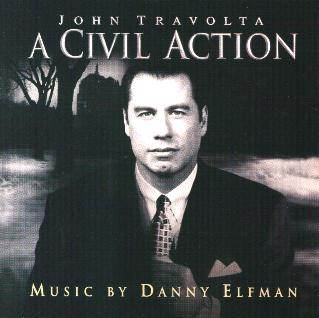
Everyone is entitled to an ‘off’ day I’m sure. When it’s on CD for you to review though, they’re not likely to get away with it ! A Civil Action is the least of Elfman’s scores in quite some time. To my ear it all too often sounds like an elaboration on To Die For (the strings in "Objections" are uncannily similar).
His practise of the art of samples has certainly raised many scores to levels of artistic intrigue. Mission: Impossible became a fascinating exercise in distinguishing live percussion from synthesised. Men In Black, Dead Presidents, and even Good Will Hunting all benefit from his quirky ensemble of sampled sounds (his "palette").What they all had however, was a sense of cohesion and a little melodic charm. A score certainly does not have to have a melody to be memorable, but when it’s left to leap all over the place like this it makes for a very uninvolving listen unfortunately.
I should not overlook its few points of interest, such as the innovative guitar work in "Civil Theme", or the lovely use of mixed choir for "The Letter". Sadly the rest is just too familiar and nondescript.
Reviewer
Paul Tonks

and Ian Lace adds
Danny Elfman can always be relied on to write an interesting score and even though this new music for A Civil Action has, perhaps, as Paul Tonks comments, too many familiar ingredients, I was impressed enough by his rhythmic vivacity and instrumental colour. I particularly liked evocative tracks like "The River"and "Water" and his more pensive strings material and limpid harp figures in "Why?"
Reviewer
Ian Lace

Danny ELFMAN Edward Scissorhands OST
MCA MCAD-10133 [49:13]
It is with some trepidation that I attempt a review of this now nearly 10 years old score.
I have collected so many gushing comments and opinions, that it seems almost unnecessary to add to them. So instead, I will repeat some for the casual reader.
Alongside my own appreciative recognition of its debt to Prokofiev, I know several composers who have ‘got’ the score once they saw that link. The portrayal of fairytale innocence could so easily have slipped over into maudlin excess, but a rooting in a classic style didn’t have to mean that. So by combining with his own inimitable unpredictable sense of rhythmic structure and penchant for peculiar instrumentation, Elfman hit upon the sublime result that speaks universally to the heart.
Those composers cite it as among their favourite contemporary scores, and certainly of Elfman’s own body of work. I mean for their praise to stand as worthy testimonials, but then there are my friends who were reduced to tears by the film. I will always remember seeing a Horror fanzine placing the album above thrash metal entries in CD reviews when the film was released!
How would the sight of Depp in Burton-mimicking dress and fright wig have been perceived without the Paulist Choristers of California ? Could anyone take the clash of suburbia and Hans Christian Anderson seriously without the tinkling of a harp and triangle ? Ultimately the film and score’s "Grand Finale" defy anyone not to reach for the tissues. It sums up this symphony of the lover’s soul as magically as anything ever has in the history of cinema. This is quite simply one of the greats.
Reviewer
Paul Tonks
tar.gif)
and one score that might have been by Elfman:
Howard SHORE Ed Wood The London Philharmonic Orchestra
HOLLYWOOD HR-62002-2 [43:58]
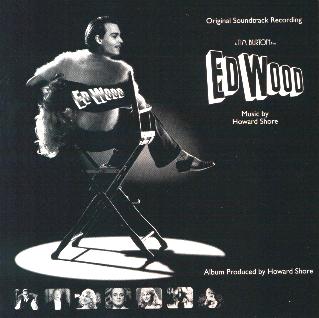
To date this is the only Tim Burton movie without a Danny Elfman score (‘creative differences’). David Cronenberg’s regular filled the shoes with a score Edward D. Wood, Jr. would have been overjoyed with. It plays up the kookiness of his nonsensical plots and haphazard directing style. There’s lots of Theremin and Ondes Martinot throughout, notably in the bravura "Main Title". Thematically derived from, the titles really lay the groundwork later on, although some nice brief themes do surface, such as the extension of Swan Lake for Bella.
Keeping the chintz appeal alive are cues such as "Elmogambo", "Kuba Mambo", and "Nautch Dance" - the last two being source cues.
"Ed & Kathy" showcases the sweet love theme which matures into a grand noble statement of Eddie’s dreams. This is perfectly coupled with the patriotic swell of "Eddie Takes A Bow" where snare drums and bell underline a brass march.
A couple of snatches of dialogue gradually wear on the listener, but it’s otherwise hard to fault a genuinely perfectly matched score.
Reviewer
Paul Tonks
tar.gif)
Maurice JARRE Lawrence of Arabia OST - Music played by the London Philharmonic Orchestra conducted by the composer
CINEPHILE/CASTLE CI CD008 [33:29]
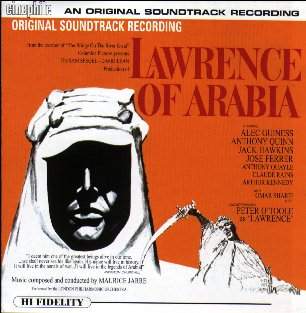
Jarré, it is too easily forgotten, is a film composer capable great musical achievements. In Lawrence and most especially in the 1980s sci-fi film Enemy Mine (when are we going to get a CD of THAT score?) he contributed scores of the highest distinction. The desert theme from Lawrence is well known and justifiably so. But this theme (which reappears often) is contrasted with a hearty jollity and exotic Moroccan local colour. The score starts with some thunderous drums but soon relaxes into the big theme and here the shortcoming of this disc asserts itself strongly.
The sound quality does nothing for the music. The original tapes must have suffered from technical degradation in storage. The sound is rather fragile and coarse where some refinement and luxury appointments would have paid dividends. I am afraid that I can only recommend this for its collector's value as an artefact reproducing the artwork of the original film and LP. The visual dimension, as with all the Cinephile series, is faultless and the notes are good. Even the disc is designed to look like one of those authentic film cans. Playing time is distinctly short.
My expectations for this CD were very high. If you want the score then go for the Silva Screen re-recording. I also noted some extremely long silences between tracks and the timer counter was running through these as well.
Reviewer
Robert Barnett

Trevor JONES Titanic Town OST
ISLAND CID 8081/524 601-2 [40:25]
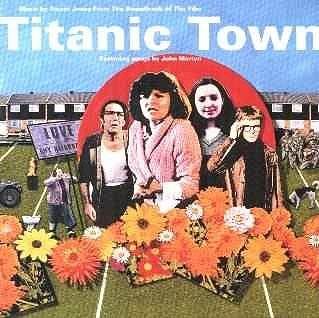
This has to be the most relaxing album I have heard in a long time. 5 songs from John Martyn’s dreamy vocals are calming enough, but then woven in-between are some surprisingly subtle cues from Jones. The sound throughout stems from different guitars in conversation, and in "The Meeting" that gets backed by Irish string rhythms and drums.
Another soundtrack rendition of "Danny Boy" might put the avid collector off, but this is one of 2 songs with vocals from Nualla O’Neill (the other being an alternate to the opening version of "May You Never" from Martyn). Her lovely voice and the unexpectedly toe-tapping rendition of the classic really add something to the collection. A demonstration of how to breathe respectful new life into something, if nothing else.
Everything was put together by Jones and his close collaborators Kipper and Gareth Cousins, with the former singing all the vocals in the catchy tune "Crying Out Loud". The team effort makes for a very refreshing listening experience. I hope it can be taken as a compliment by all involved when I say that this is ideal music to drive to. There is nothing traditionally ‘road’ about the music. Its just the sort of easy pleasing to make zipping by scenery come alive.
Reviewer
Paul Tonks

Trevor JONES The Mighty Geoffrey Alexander Conducts the London Symphony Orchestra
PANGAEA 61868 10028 2 6 [65:46]
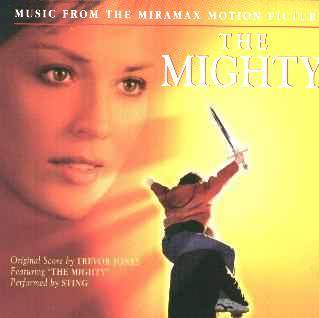
The key word for this score, is understated. For its greater part, the music sensibly takes a back seat to the emotional storyline. Thankfully it never ‘overdoes’ it. The performances could easily have been disrespected by too much schmaltz, but Jones found one of his most intriguing mixes of style to complement them.
All through "Dreaming Clouds", "First Flight", and "Life’s Rough" it is with piano and soft strings that the boys’ developing friendship is communicated. The occasional comedy is allowed to speak for itself on screen without being hammered home in music. The subtle approach also opens both of the albums’ sizeable cues - "The Mighty Quest" (over 14 minutes), and "My Noble Knight" (over 8). The first develops from a piano piece reminiscent in style and mood of Stanley Myers piece from The Deer Hunter. It moves between synth passages and a gentle orchestral performance of the principal theme, and builds at one point to a charging moment of drama that is the only telltale moment of Jones’ recognisable style. The large scale dynamics of Dark City and Merlin are recalled, but it certainly doesn’t detract.
With "My Noble Knight", both film and score succeed in a wrenching tug on the heart strings. It is almost the film’s climax - a tragedy you hate to realise is coming. The extended sequence is given over completely to Jones’ music, with no other sound whatsoever. The gorgeous elegy he has created deserves to stand as one of his premier achievements.
The other sound woven into the whole adds to this being such a charming surprise of styles. Since the boys are fantasising about the Arthurian legends, who better than the composer of Excalibur and Merlin to inject some medieval pomp ? "Past Times" introduces what seems like a court dance immediately, and it re-appears most dramatically after the harmonica folksy segment of "Free To Fly".
The song co-written with Sting is for once an integral part of the film, with appropriate lyrics and features in a montage sequence of the boys first befriending each other. It has 2 different versions on offer too. "Future Times" - the last score cue of the disc - is effectively an instrumental of the song. Rounding it all off is "Let the Good Times Roll".
Reviewer
Paul Tonks

Horner Corner
As we draw towards the 1999 Academy Awards celebrations we look back just once more at some of the work of 1998's Oscar winner
James HORNER More Music from Braveheart James Horner conducting the London Symphony Orchestra
LONDON 458 287-2 [68:47]
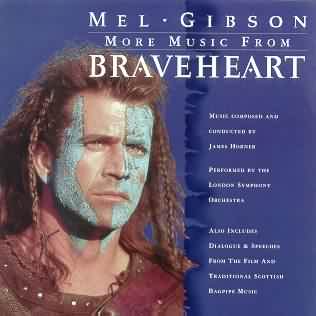
Well if Titanic can be revisited, why not Braveheart? So what has this album got that the original one hadn't? Well, not too much except - just four previously unreleased tracks and a lot of the dialogue from the film plus five tracks comprising fifteen numbers of Bagpipe classics played by 1st Battalian Queen's Own Cameron Highlanders which you will consider either heaven or hell according to your taste.
The new material comes from early in the film and is represented by the four cues: "Outlawed Tunes on Outlawed Pipes" which is just that, pipes against long held plaintive and atmospheric string chords; early Church mode music, sung a capella, for "The Royal Wedding"; joyful folk music, with pipes and drum for "Scottish Wedding Music"; and sad, plaintive music with electronic wailings for "Prima Noctes".
The screenplay was quite memorable so that the dialogue, integrated with Horner's music makes for a rather winning entertainment The dialogue includes a number of tracks with Robert the Bruce's narrative, King Edward the Longshanks' (the magnificently wicked Patrick McGoohan) ironic declamation - "The trouble with Scotland is that it's full of Scots... Perhaps the time has come to reinstitute an old custom - Prima Noctes ... If we can't get them out we'll breed them out!"; and William Wallace's impassioned cry to battle, "Sons! Of Scotland,... Will you fight?..." followed by the sonically spectacular battle music. Although Wallace's heroic call is sub- Shakespeare Henry V and Laurence Olivier, it is nevertheless a thrilling highlight of the film.
An album for dedicated Horner fans.
Reviewer
Ian Lace

James HORNER Star Trek II: The Wrath of Khan OST
GNP Crescendo GNPD8022 [44:50]
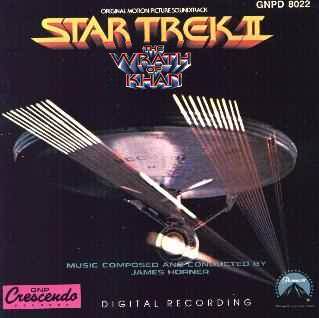
At the very start of his career, Horner was knocking out pure genius on a daily basis, and this was the big break wherein it first truly got to shine. Every moment of Trek 2 shines with a satisfied smile on its face, knowing it works to picture with perfect exactitude.
Beating the audience appeal of the first movie wasn’t a tough job, but matching the quality of the score was going to be. Director Meyer didn’t manage to secure Miklos Rozsa sadly, and instead turned to this particular freshman to see if he could ‘get’ the nautical and classical vision her shared with creator Roddenberry. If "Main Title" doesn’t answer that question for you, you need proceed no further.
Let me highlight the highlights: Khan’s theme / the eerie underscore when Chekov finds Khan / the submarine-like "Battle in the Mutara Nebula" / the wondrous music for he Genesis cave / the perfect balance of adrenaline suspense with growing fear for Spock in "Genesis Countdown" / the silence in the scene between Kirk and son.
Perhaps the best musical anecdote about this film is that Horner opposed the use of ‘Amazing Grace’ for Spock’s funeral. It would have lost us the beautiful orchestral reprise he did, but his belief that it would spoil the scene was mostly right.
If only they made ‘em like this now...
Reviewer
Paul Tonks

James HORNER Star Trek III: The Search For Spock OST
SILVA SCREEN FILMCD 070 [43:05]
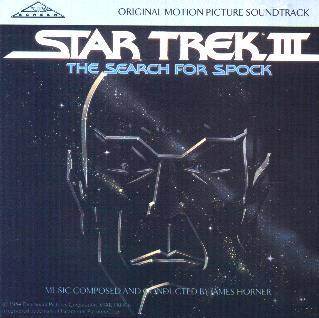
It’s surprising Horner was kept on here, since Nimoy in occupying the director’s chair must have been dying to bring in his chum Rosenman. Ah well - at least he got to drip mud all over number IV ! The obvious reason for the continuation was in that the 2 films really form parts 1 and 2 of story in three parts. The groundwork for III is so obviously laid in II.
Being a tamer beast however, Horner has less of an explosive reply to wield at the visuals. The Klingons get the bombast, but this is a more intimate affair. Both "The Mind-Meld" and "Returning To Vulcan" are terrific examples of the composer at his most restrained.
The album’s true highlight is "Stealing the Enterprise" which is a succession of one agreeable musical set-piece after another.
Only a slightly lesser work than II, it still makes for the dreams of glory days in Horner’s career.
Reviewer
Paul Tonks

James HORNER The Rocketeer OST
HOLLYWOOD HR-61117-2 [57:13]
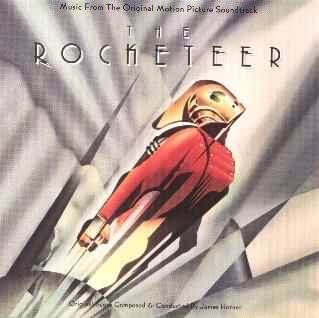
The "Main Title" and main theme of The Rocketeer have always managed to pull off the same trick as The Blue Max for the listener by instantly conjuring an image of ‘flying’. That’s the immediate success of the score, but it’s coupled with some of Horner’s most detailed action writing, and a beautiful love theme.
There are plenty of familiar licks in the music that hearken back to the Star Trek scores, and pre-date Titanic amongst others. Yet its arrival in 1991 was a milestone since Horner seemed to have weaned himself off genre pictures altogether.
"The Flying Circus" is undoubtedly the score’s highlight. It ‘Mickey Mouses’ the aerial display of Cliff Secord’s first flight superbly, with lots of ascending and descending chords.
Another terrific showcase is "Jenny’s Rescue". With snatches of Timothy Dalton’s baddie theme throughout "Rendezvous At Griffith Park Observatory", that too is a great cue and what helps make them so are their generous length.
The two source songs may seem like padding being sequenced among the score cues, but they were featured prominently in the film, and do sit rather well in context.
What a shame this never became the franchise it was planned to be.
Reviewer
Paul Tonks

See also Ian Lace's review last January
http://www.force9.co.uk/music/film/jan99/horner.htm
Interview with Danny Elfman, composer
reproduced with permission of Cinemedia Promotions
1. What attracted you to A Simple Plan?
[Director] Sam Raimi. I worked with him twice before and I just adore him. I just love him.
2. A Simple Plan is a more subtle score than some you’ve written in the past, is that more difficult than a bombastic score?
Absolutely. There’s nothing easier than being bombastic, which is exactly why I don’t go for your standard action films. Anything works as long as it’s big and loud. Bombastic is easy. I think a relatively talented 12-year old with a couple of good orchestrators could score most of the big mega-blockbusters that are out in the last couple of years.
3. What kind of instrumentation did you use for A Simple Plan?
Very often in a movie I design the score around a sound or sounds that I think will be unique to that picture. Certainly in a movie like A Simple Plan it needed some special or unique tones, the tone of the movie was very tricky. So there are 2 thematic areas, one of them was a flute ensemble. It was a fun orchestra for me to work with because there was really no brass, no percussion. It was just stings and flutes, lots of flutes, 9 of them, mostly alto and bass. That was kind of a fun different thing, very, very simple, sparse ensemble led by alto and bass flutes.
The other part of ii was these specially tuned pianos that I prepared before I started and specially tuned banjos so I worked the music around the sounds of these micro-tuned piano chords and special banjo samples that I did myself. I tried to make the heart of it. Starting with these two odd tonal groups, I started composing the score. It was really fun, different, very simple score, really, for A Simple Plan. I didn’t mean it as a pun, it really was. A lot of people that work with me very frequently were very shocked when they came in the room, to see no brass or percussion.
4. Do you have much control over your score on a soundtrack album?
No, unless it’s an album of the score, then I do. In an album like Good Will Hunting or Men in Black which is really an album of songs with a bit of score I don’t really have much say, because it’s not really about being a soundtrack, it’s about marketing something to help promote the movie. So when an album, i.e. A Civil Action or A Simple Plan, is the score, then I produce the album.
5. Do you do most of your scoring in here (US) or abroad?
I’ve been scoring strictly here. I’ve done 34 films. I’ve done only 2 of them abroad, although the next 2 are, oddly enough. Not for union costs, because they’re both British based productions. All the post is happening there. I prefer to score at home, not because they don’t have excellent orchestras abroad, they do, I’ve got wonderful performances from London both times I’ve played there, but simply for the fact that it’s much easier on me to be home. Close to all my own resources.
One thing I should point out is that I do a lot of the performing on my scores, which not everybody’s aware of. In A Simple Plan, A Civil Action, and (the upcoming) Instinct, anywhere between 20 and 40% of the music on any particular cue is coming from me. So that provides a difficulty in terms of leaving because it means I have to bring a lot of stuff with me. I’m running simultaneously with the orchestra, quite a bit of percussion. I don’t run, as some people do, phony orchestra sounds, the strings are all strings, the brass is all brass, the woodwinds are all woodwinds. If you listen to the underlying texture beneath that there might be anywhere between 20-40 tracks of me playing percussion and odd string struck sounds, glass sounds, harmonic sounds sounds that I collect and use.
Pretty much any sound you hear in any of my scores, that isn’t traditional orchestral instruments, is coming from my own performance. Because of that it’s much easier for me to be close to my home. I don’t pre-lay it on tape, so there’s a difficulty in terms of going oversees, how do I bring all these with me, because I want them all running live with the orchestra. It would be easy to pre-lay it on tape, but with it on tape you lose your ability to change a tempo or to catch something differently. If a director is sitting there going "I like it, but I really want it want to catch this thing earlier, I think we’re a little late on that," you can’t do it if you’ve pre-laid it. So I have everything running live with the orchestra, and it gives us the flexibility to speed up or slow down the tempo, or do anything more with it. With these next 2 projects I’m going to be bringing a lot of my equipment oversees. More than anything else that’s what keeps me, when I can, working close to home. And I literally might want to grab an instrument with a particular sound to redo something. If I’m oversees I can’t do that because they’re not traditional instruments, they’re odd things, just my own stuff.
In A Simple Plan all of the re-tuned pianos, all of the banjos all of the strummed instruments, all of the glass all of the percussion, zithers, and hand drums, there’s a lot of stuff that you don knowit’s there bit it’s there, it’s all my stuff. A Civil Action, all of the marimbas, all of the glass, lots of peculiar little instruments and organ type sounds, synth work is mine. In Instinct it’s like a plethora of all of the xylophones, marimbas, thumb pianos and African instruments and drums. That’s all my own stuff.
6. Who are some of your favourite directors to work with?
My only repeat directors would be Gus van Zant and Tim Burton and now Sam Raimi. I like working with all of them. They all give me a very long leash to work on, which is where I’m happiest.
7. So you don’t come in and do films with 1-week turnarounds, where you don’t know anything about the film going into it...
Some of their films will be tight turnarounds and some of them will be looser but it’s more creatively they let me do my job. It’s just that simple. And many directors just don’t have the ability to let you do that. Because they all have to control it so much that you can’t really bring much to the party. All three of them allow me to bring something to their party.
© Film Music on the Web 1998. All rights retained. Reviewers retain copyright on their reviews.
COMPETITION WIN a CD of your Choice from Crotchet

There are more >>>>>
Search the Crotchet database from here
Discs on these pages are offered for sale. There is also a page of search engines from a selection of on-line retailers here.
Please support this web-site by buying your discs here.
Disclaimer: Every effort is made to make sales links to the correct disc but, in the end, you must take responsibility for checking that what you are purchasing is what you want. Some of these discs were not actually available for sale at the time of posting but a link has been made in anticipation of their forthcoming availablility.
Return to Index Page
e-mail Len Mullenger len@musicweb.force9.co.uk